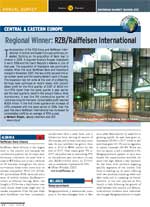In our 15th annual survey of top banking performers in emerging markets, we name those banks that are consistently providing high levels of service in fast-evolving markets.
 |
|
Download PDF (2 MB) |
The leading banks in many emerging markets are reporting big gains in earnings, at a time when money center banks in the industrialized economies are suffering significant losses as a result of the global credit crisis. Fast economic growth and lack of exposure to the US subprime mortgage problems are two reasons that well-managed banks in emerging markets are performing so well.
This out-performance is true not only of banks operating in the oil-rich countries of the Middle East and the fast-growing export economies of Asia but also in some African countries, as well as in Central and Eastern Europe and in Latin America.
International banks from the major industrialized nations and increasingly aggressive regional financial institutions are providing growing competition for local banks in emerging markets. Attracting and keeping talented employees is the biggest challenge facing most financial institutions operating in these markets.
While bankers in the developed economies are bracing for an economic slowdown, their counterparts in the emerging markets are more worried about a flare-up in inflation and keeping up with the fast pace of growth in their home markets. The emerging market banks are doing their best to keep costs under control and to meet the rapidly expanding requirements of their customers. Many of them are opening new branches and acquiring competitors.
In many emerging markets, banks are also extending a hand in providing desperately needed social services, including support for healthcare and education. Standard Chartered Bank Zambia, for example, is helping to distribute insecticide-treated mosquito nets to fight malaria. Bankers are also paying more attention to the effects of their lending policies on the environment and are introducing technology that makes doing business in emerging markets far simpler than it used to be.
In selecting this year’s winners, we relied as always on input from industry analysts, corporate executives and banking consultants, as well as research by Global Finance’s editorial team. Our selection criteria included knowledge of local conditions and customer needs, growth in assets, profitability, strategic relationships, experienced staff, innovative products, competitive pricing, level of non-performing loans and use of technology.
Altogether, we chose the best emerging market banks in five regions of the world and 91 countries. The winners are not always the biggest banks but, rather, the best banks—those with the qualities that corporations should look for when choosing a bank. These are banks with effective risk-management systems, first-rate service and good corporate governance. Many are involved with microfinance and lending to small and medium-size businesses, as well as meeting the needs of the growing ranks of major corporations in their countries.
Fast-growing emerging markets such as China and India are helping to keep the global economy afloat at a time when the developed economies of the United States, Europe and Japan are faltering. Strong spending by oil-exporting countries also is helping to support growth. The best banks in emerging markets are helping to ensure that banking systems in these countries offer the products and services necessary to promote development and, ultimately, improve the living standards of the majority of mankind. The winners of these awards are deserving of them because of their hard work and vision, not simply because they happened to be based in the right country at the right time.
Gordon Platt



